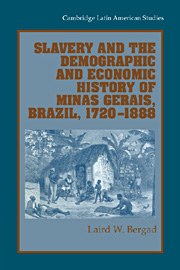Book contents
- Frontmatter
- Contents
- List of illustrations
- List of tables
- Preface
- Acknowledgments
- Maps
- 1 The mining-driven economy and its demise: from settlement to 1808
- 2 Economic transformations, 1808–1888
- 3 Demographic rhythms from settlement to the census of 1872
- 4 Demographic aspects of slavery, 1720–1888
- 5 Economic aspects of slavery, 1720–1888
- 6 Conclusions
- Appendixes
- Glossary
- Bibliography
- Index
4 - Demographic aspects of slavery, 1720–1888
Published online by Cambridge University Press: 16 February 2010
- Frontmatter
- Contents
- List of illustrations
- List of tables
- Preface
- Acknowledgments
- Maps
- 1 The mining-driven economy and its demise: from settlement to 1808
- 2 Economic transformations, 1808–1888
- 3 Demographic rhythms from settlement to the census of 1872
- 4 Demographic aspects of slavery, 1720–1888
- 5 Economic aspects of slavery, 1720–1888
- 6 Conclusions
- Appendixes
- Glossary
- Bibliography
- Index
Summary
The previous chapter considered general data on the demographic history of Minas Gerais by examining changes occurring between official census reports conducted in specific years. This chapter will examine year-by-year transformations taking place within the Minas slave population using the inventário collections described in the Preface.
Data on the birthplace of slaves is fairly detailed in these records, and in the case of African-born slaves notations indicated the ethnic group or the region within Africa where slaves were thought to have originated. Despite the great diversity of African origins, in the discussion that follows I have divided the slave population into African-and Brazilian-born. The changes taking place in these broadly defined origin categories can be used as important analytical tools to interpret demographic variables such as reproductive patterns. They can also be used to address central historiographical issues, such as the timing of the African slave trade to Minas and the relative importance of Brazilian-born and African-born slaves in the formation of the Mineiro slave population. Figure 4.1 depicts trends in the origins of the slave population in the different regions studied and in the overall data base.
These images confirm the steady process of Brazilianization taking place among Mineiro slaves during the eighteenth and nineteenth centuries.
- Type
- Chapter
- Information
- Publisher: Cambridge University PressPrint publication year: 1999



